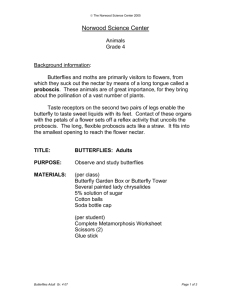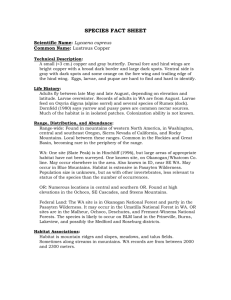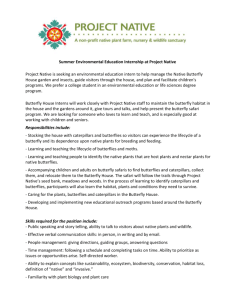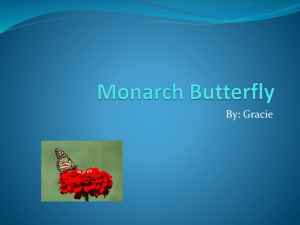Introduction to the Life Cycle of Butterflies
advertisement
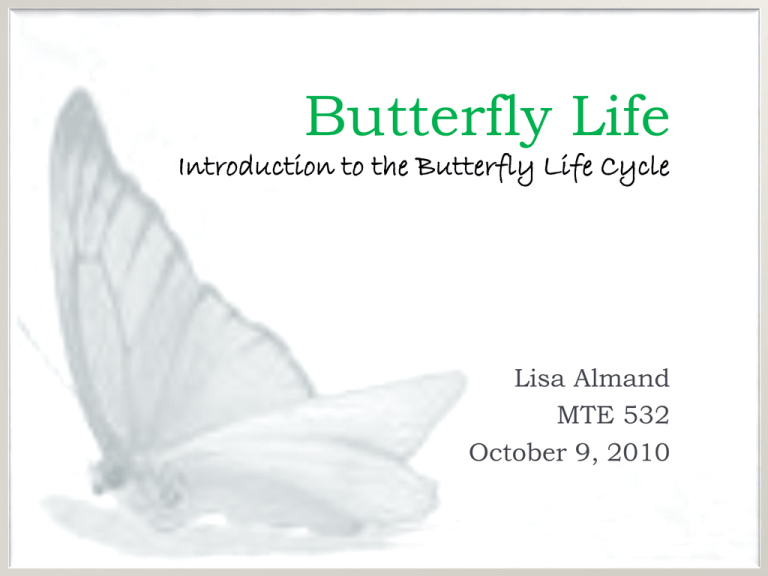
Butterfly Life Introduction to the Butterfly Life Cycle Lisa Almand MTE 532 October 9, 2010 Introduction The lesson plan presented is the initial lesson plan in a 2 week unit on the life cycle of butterflies. The lesson plan is followed by more in-depth lessons on each stage of the life cycle as well a lesson on butterflies from around the world. Upon completion of this lesson students will be able to identify the stages of the life cycle and recognize it as continuous pattern. Overview of the Lesson: Title: Introduction to Butterfly Life Cycle Grade: 2nd grade Inclusive Classroom Time Allotment: 2 – 30 minute lessons – Day 1 & 2 Standards and Objectives Oklahoma P.A.S.S. Skills Science Standard 2: Life Cycles and Organisms Plants and animals have life cycles that include developing into adults, reproducing, and eventually dying. The details of this life cycle are different for different organisms. Instructional Objectives Students will be able to recall the four stages of the butterfly life cycle. Students will be able to explain and identify the stages of the life cycle in order and predict that a new cycle will begin at the end of a completed life cycle. Students will be able to recognize the life cycle as a repeating pattern. Math Standard 1: Algebraic Reasoning: Patterns and Relationships Describe, extend, and create patterns using symbols, shapes, or designs (e.g., repeating and growing patterns made up of sets of shapes or designs, create patterns by combining different shapes and taking them apart). Materials Needed The book Starting Life Butterfly Four stages handout spiral pasta-caterpillar shell pasta-chrysalis bow tie pasta-butterfly small pasta or lentil - an egg crayons or markers glue Patterns worksheet Poem handout Quiz Instructional Activities Anticipatory Set – Ask students if they have ever caught a butterfly or played with a caterpillar. This will get their brains going. Pull up a KWL chart on the smart board and fill out with the student’s comments. Ask students what they know about butterflies. Then, ask them what they know about caterpillars. Then, ask them what they want to know. Write down student’s responses and save the chart for later. Introduce the vocabulary – Egg, Pupa, Larva, Chrysalis, Adult, Pattern Read the book, Starting Life Butterfly by Claire Llewellyn. Stop at the end of each phase and ask questions. Instructional Activities After reading the book, review the stages of the life cycle and re-emphasize the concept that the life cycle starts over after the butterfly develops and lays eggs, and so. Pass out the Life Cycle Activity worksheet. Pass out the different pasta shapes. Ask students what stage each type of pasta resembles and explain the activity. This activity can be used as a formative assessment. Students complete activity. Life Cycle Instructional Activities Begin Day 2 with the use of technology. Watch the life cycle video found at Review the vocabulary words. Review the life cycle with students. Be sure to emphasize each stage and its proper name. Review the KWL chart (formative assessment) from the beginning and ask students what they have learned. Write their responses on the smart board KWL chart. Express to them how much they have learned about butterflies, life cycles and patterns. Hand out the butterfly poem. Read it to the students, then, have students read aloud with you. Pair students with a partner and have them read the poem repeatedly for their buddy as a fluency builder exercise. After students buddy read the poems multiple times, have them return to their desk. Administer quiz. Summative Assessment http://www.cheshire-butterflies.co.uk/species/speciesdetails/ot/life_cycle_1.htm Extension Activities for Diverse Learners Learning Disabilities Modified Worksheets and Handouts Paired with higher level students for activities Provide pictures of life cycle with pasta activity Poem can be read to students Modified quiz Gifted Students Collect caterpillars and butterflies for class observations Make diorama of the life cycle of butterflies. Write a poem about butterflies. Assessments Students will be observed during the KWL process (formative). Students will be assessed (formative) during the life cycle activity through observation. They will also be assessed (formative) during the patterns worksheet. At the end of the second day, students will be given a quiz (summative) that will be graded. Rubric - Formative Poor Fair Good Excellent Assessment Students demonstrate no new knowledge about life cycle of butterflies Students show some interest and new knowledge after the lesson on butterflies Students reveal learning many new things regarding butterflies. Students express learning the complete life cycle and know it is a pattern. Activity is not colored, no sentences are written, pasta is used incorrectly Some coloring, sentences not complete, most stages are correctly drawn Colored and sentence are almost complete. Stages are near correctness Color is great with Pasta Activity details. Complete sentences and stages are correct Does not successfully complete pattern activity. Struggles to complete activity and does not complete without assistance. Successfully completes the activity but makes a few mistakes. (May struggle with completing it in a timely manner) Successfully completes activity in a timely manner with no assistance. Students need additional Students need to review review and lesson may concepts and lesson need slight should be reviewed improvements Students are clearly learning and lesson is successful. Students need more instruction and lesson needs modifications KWL Chart Pattern Worksheet Rubric – Summative Quiz Poor - D Incorrect labels on life cycle. Patterns not complete and mostly incorrect. Picture not colored. No name on paper. Fair – C Not all labels are correct. Many patterns are incorrect. Coloring is minimal. Good - B Labels have only one mistake. Patterns are mostly correct and chart is colored. Excellent - A All labels are correct on life cycle. Patterns are all complete accurately. Coloring is complete and detailed. Conclusion The Introduction to the Life Cycle of Butterflies lesson plan is followed by a series of lessons on each stage of the life cycle. Throughout the lesson, and the entire unit, the needs of diverse learners is addressed with many accommodations and differentiated activities. The lesson plan integrates math and science concepts, as well as reading fluency and technology. Upon completion of the unit, students will have an in-depth understanding of the life cycle, various mathematical concepts, technology, social sciences, and literature. References Martin, R., Sexton, C., Franklin, T., & Gerlovich, J. (2005). Teaching science for all children: An inquiry approach (4th ed.). Boston: Pearson. Oklahoma Department of Education. (2010). Oklahoma P.A.S.S. Priority Academic Student Skills Grade . Retrieved October 7, 2010, from http://www.sde.state.ok.us


